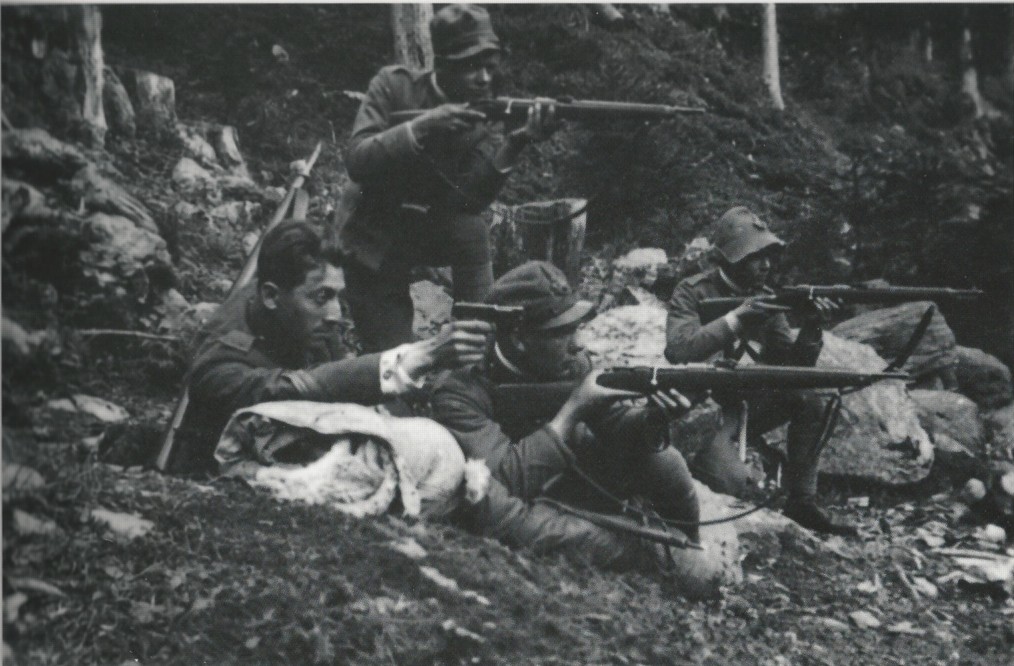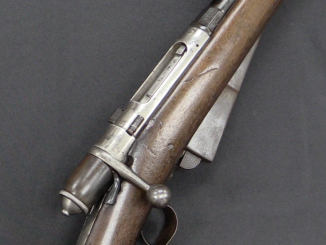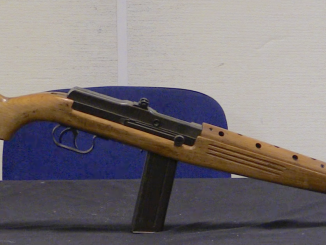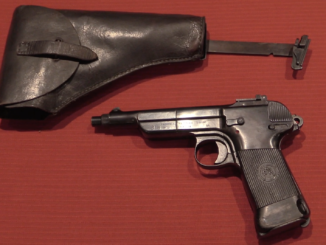
From left to right: The soldier without a hat is a sergeant holding a Beretta Model 1915 pistol chambered in 9mm Glisenti. He is resting his shooting arm on a folded coat with a lamb wool liner and the spike of an ice-ax is visible. He has a Carcano 91 TS across his back. The other three soldiers all hold the same type of rifle at the ready in a staged pose.
The soldier to the immediate right of the sergeant has the Badge Model 1892 embroidered in yellow rayon or wool, which was not officially allowed at the front. The soldier at the far right has the “alpino-hat” issued after 1910 and still in use. The soldier at top is wearing the correct subdued version of the Badge Model 1892 embroidered in black.
Photo and caption from GunBoards.com.




Hmmmm an Italian subject Ian… How apt
All that just to take out tax dodgers or bank robbers? That’s overkill!!
You get the impression that Italiams don’t like paying taxes somehow. Mind you, the last thing you need is an idiot with a 9mm firing it right next to your ear. If he tried that with me he’d be eating the butt of a Carcano, sergeant or no sergeant.
Perhaps you’d be better off dropping a water-cooled Fiat-Revelli on his head. But then again, that would make things worse. 9×19 Glisenti is rather weak compared to 9×19 Parabellum, but annoying enough if you’re caught on the receiving end at point-blank…
“9×19 Glisenti is rather weak compared to 9×19 Parabellum”
Under 9×19 Parabellum should I understand Pist. Patr. 08 or something different?
–
9×19 is one of early 20-th century cartridge designed to be “blow-back maximum” (biggest cartridge which can be used in reasonable size blow-back operated automatic pistol), other were 9x17mm Browning (.380 Auto) and 9x20SR Browning Long (for Husqvarna m/1907 pistol), this idea was also used several times often (see 9×18 Ultra, 9×18 Makarov), but all this cartridges excluding .380 Auto and 9×18 Makarov fall into oblivion, apparently there is no need for more such cartridge. If no need for yet another 9x(something) blowback cartridge is ease to understand, why not try with smaller/bigger bullet?
So far I know Mannlicher created blow-back operated pistol – Model 1901, firing powerful 7.63mm cartridge – 85 gr. Metal-covered at 1,050fps according to KYNOCH catalog (Metal-covered is apparently FMJ in KYNOCH parlance), anyone else tried to make maximum not-9mm blow-back cartridge?
Perhaps the issue is this: Why bother making a new maximum power cartridge for a given projectile when you could make a locked-breech pistol capable of handling the strongest such round?
FN Five-Seven pistol is chambered for a round intended for a carbine-length weapon. Sure, there is little recoil compared to that from a Beretta 92 given that the Five-Seven is a delayed blow-back weapon firing a relatively small projectile. But the big issues with the Five-Seven are excessive muzzle flash and a stupid media perception that penetration power is somehow equal to lethality. All the Five-Seven proves is that a pistol round can still punch through ordinary concealment in order to get people who are hiding behind said concealment. Clean penetration through a person generally doesn’t mean death unless the bullet has hit someone’s heart, liver, vertebrae, kidneys, or plainly ANY vital spots. More likely to kill a person quickly would be a .45 ACP round (or even .45 Long Colt from a Single Action Army revolver) in the intestines than a 5.7×28 through the [unmentionables].
Did I mess up?
“FN Five-Seven”
Maybe I was not exact: I mean simple blow-back not delayed blow-back designs.
“you could make a locked-breech pistol capable of handling the strongest such round”
Which will be more complicated and thus more expensive.
“Why”
If you will have smaller (lighter) bullet you can have bigger muzzle velocity with still same or lower momentum, each bullet which deals damage by EXPANSION to do it have to strike target with minimal velocity (depending on bullet design) or will not expand. More velocity mean better expansion and more damage.
Anyway I found other such cartridge:
.32 NAA (North American Arms) which is .380 Auto necked-down to .32, used in NAA Guardian automatic pistol
.32 NAA technical specs according to:
http://dailycaller.com/2013/10/03/build-your-own-the-32-naa-browning-guns/
60 gr bullet @ 1222 fps (1453 fps from 4″ barrel)
If all other factors remain the same; barrel length, powder charge weight, bullet weight, operating pressure etc
you will get a higher velocity from a larger diameter bullet – at least going from .32 up to .38 or from .38 to .45
Clearly you’ll hit a point of diminishing returns at some point, with an unfeasibly large diameter and unfeasibly thin bullet resembling a sheet of copper foil, but in general, you’re not going to gain by bottlenecking pistol cases in service pistol length barrels.
“Clearly you’ll hit a point of diminishing returns at some point, with an unfeasibly large diameter and unfeasibly thin bullet resembling a sheet of copper foil, but in general”
Schouboe tried big-light-fast bullet idea in automatic pistol
http://unblinkingeye.com/Guns/Schouboe/schouboe.html
11,35mm Schouboe launch 55 grain wooden bullet at 1625 fps, however it never become popular
D;
There is also the .25 NAA, which is a .32 ACP necked down to take a .25 ACP bullet.
The 9 x 19mm Glisenti round was one of the larger mistakes made in European firearms development in the last century. Simply put, it was a ballistic and pressure equivalent of 9 x 20SRmm Browning, intended for retarded-blowback pistols (like the Glisenti or later Brixia) or straight blowbacks like the Berettas.
Unfortunately, all of the arms chambered for it could chamber and fire full-pressure 9 x 19mm P.P. 08 as well, resulting in the inevitable consequences.
This was compounded by the Italian Army issuing 9 x 19mm SMGS like the Beretta M1918 and later M1938, plus special high-powered (and high-pressure) ammunition for same. And not everybody knew enough to tell which round was which from the headstamps.
The moral is, figure out what cartridge and what loading you intend to use to arm your forces, and then stick to it.
The objective, after all, is to hurt the other guy, not your own.
cheers
eon
“M1918 and later M1938, plus special high-powered (and high-pressure) ammunition”
Yes, but notice when 9mm Glisenti was adopted – in 1910 – no-one thinks about sub-machine gun at all and also so far I know battles between Italy and Germany (then only major country using 9×19 Parabellum as default) were unlikely.
What will happen if MAB 38 will be feed with 9×19 Glisenti cartridge, it become repeating weapon, i.e. needing manual cycling after each shot or still remain automatic but with lower rate-of-fire? If second then it is possible that Italian Army consider that as possibility to use in DIRE situation and possibility of putting 9×19 for MAB 38 into 9mm Glisenti weapon as acceptable cost
Stop!! Pay your taxes or we’ll shoot!!! I don’t see how anyone could be a tax collector and feel proud about it. Nothing more that a bunch of armed thugs.
Hope the IRS aren’t viewing this site. I wouldn’t want them getting any ideas.
Truly forgotten part of History…The Italian campaign in the Alps (evidently some of these dudes are connected to the Alpini) is always neglected in histories & accounts opf the ‘Great War’. I’m guessing that this is a ‘great War’ era picture (posed though it may be)…The Italians had a long history of conflict with the Austro-Hungarian Empire – going back YEARS before the ‘Great War’…I would expect these guys aren’t out enforcing collections of taxes from the goombahs in arrears…they’re fighting the Austrian…
“Italians had a long history of conflict with the Austro-Hungarian Empire”
BTW: Interesting historic fact:
After Jean-Henri Dunant (businessman from Switzerland) see soldiers wounded during Battle of Solferino (1859, ALLIED(FRANCE,ITALY) vs AUSTRIA) without much medical care he decided to create RED CROSS he choose red cross sign which was in fact Swiss flag with swapped colors.
Roger…I knew about Dunant and the swapped colors, but forgot the impetus being Solferino…the Italians suffered brytal casualties in the alpine fighting during the ‘Great War’
Reason for this were longstanding interfering claims going back to Middle ages. Also, not to forget Austria played domineering role in Italy up to unification of Italy in 2nd half of 19.century and Austrians were generally hated by wide part of population. But relations with French were not much better.
http://www.worldhistory.knowledge4africa.com/modern/realism-03.jsp
Later, in years leading to WWI many “radical” Italian elements (today covered by name terrorists) committed several assassination attempts (some successful) at members of Austrian Royal family. There is lots of material to cover here. There is ALWAYS a reason why.
There still isn’t much love lost between French and Italians, If we ignore Carla Bruni and her midget…
Napoleon had the Louvre built to house the treasures that his forces had looted from Italy.
French forces put down the 1848 rebellion.
France still occupies the Italian city of Nice.
On the other side, Italian troops were used by the Axis to burn out French farms and villages in the Alps and Vercors.
Up until 1860, Lombardi and the Veneto were part of the Austrian empire.
Regarding the Austrian Italian Front in WW1 – these Gentlemen have been doing some amazing work recording the remains at up to approx 12,000 feet altitude (3,600m) on the glaciers http://arc-team-open-research.blogspot.co.uk/2016/04/glacial-archaeology-about-challange-to.html
Right and this goes into these days and is entrenched in grassroots. I recall some years back that mom of our neighbour (1st gen Italian) told me on address of his son’s wife: “… she is not good – French… and she smokes!”. Three strikes and you are out. And it happened; some two years after they were divorced and guy happily pays on two children. Oh well.
My policy is not to mix into other people’s problems; that is to say be strictly impartial. However it is good to know that two autonomous regions of Italy between 8th century and 1919 part of Austria:
https://en.wikipedia.org/wiki/Trentino-Alto_Adige/S%C3%BCdtirol
They are two MOST prosperous regions out of 20 country has. What else to say.
Oh yeah, shooting from behind cover, they were good at that. I do not know nothing about mentioned Regia guardia di finanze, but common units had their reputation…. well deserved. My both grandpas were facing them.
Oh man, last year I visited (shortly after 100th anniversary of breakout of hostilities in May of 1915) locations of battles on Socha/Isonzo. I wish everyone who travels to Slovenian-Italian frontier (today as pacified as it can be) to visit museum in Kobarid/ Caporetto. One of best of the kind.
http://www.slovenia.info/en/Museums-and-galleries/Kobarid-Museum.htm?muzej=1962
Pay your taxes you fool !!! Love the posed pic. Italy have a long history of decentralized states so they had to create those special financial armed forces to made the locals more compliant to Rome’s policies. The modern version of this service: https://en.wikipedia.org/wiki/Guardia_di_Finanza
It may be as you say and it is not related to events of WWI at all. Actually, all countries in the region of the period had similar institutions (including Austria-Hungary) and they were primarily enforcing border duty (customs) regulations.
Yes they were more on customs duties and fighting all kind of illegal traffics but the pic is staged and I don’t really know but I have the feeling, maybe because no grenades, more ammo, bayonets, the visible badges etc…that’s not on the frontime Alps…maybe a recent postwar pic.
Or in fact shortly before the war…
Keith said: “If all other factors remain the same; barrel length, powder charge weight, bullet weight, operating pressure etc
you will get a higher velocity from a larger diameter bullet – at least going from .32 up to .38 or from .38 to .45”
Thinking about this Keith, You are gonna see a very great diffence in bullet shape if you attempt to keep the same weight in a smaller caliber…for instance, If you neck down a .45 ACP case (or, conversely, use a case that holds the same volume/weight of powder as a .45 ACP) and use a .38 caliber (which would actually be .357, I believe) bullet, but you try to keep the bullet at 230 grains (.45 ACP ball weight) you are going to be looking at a rather longer projectile, that will have much different aerodynamic qualities…not to mention, different cross-sectional densities on target.
In effect, something like the 200-grain Super Police .38 Special bullet. Which was virtually an overlong target wadcutter with a rounded front end.
On penetration of the body cavity, instead of rotating once and continuing back-end-foremost, it started tumbling and kept doing it. Leaving a rather nasty permanent crush cavity in its wake.
The moral is that it’s not so much how much kinetic energy a projectile has as it is what it does with it upon arrival at- or in- the target.
cheers
eon
Basically who my Dad’s grandfather spent the entire Great War fighting against
(Definitely optional) Weapon of choice scenario:
Location: occupied zone, some small town close to a medieval castle currently used as the enemy’s strong hold.
Alright, it appears everyone survived the air drop. It’s nearly dawn, so let’s hide the main weapons canister (I don’t even know why we were given this). Most of the inhabitants of the town ahead are actually resistance members who will readily assist in this operation. They’ve procured some spare local police uniforms and stolen enemy soldier uniforms (through the laundromat), along with the weapons used by both groups in the region (and fake id papers). It appears that the other team is moving lots of heavy stuff into that castle, and they are stationing heavy armor outside the perimeter. Our main objectives after infiltrating the castle are below:
1. Estimate current base strength as aerial recon can’t get close enough (flak guns everywhere! Darn it all!)
2. Steal important documents or copy them with microfilm cameras
3. Free POWs held in the castle dungeon. A false transfer paper with signatures has been provided
4. Verify whether any special weapons are being developed
5. Sabotage communications and radar equipment
6. Escape without blowing your cover
Given a choice, which disguise would you pick, and what weapon would you have on your person?
Police disguise
1. Rast & Gasser 1898
2. Nagant 1895 police model
3. Mauser 1934 pistol
4. Walther PPK
5. MP-18
6. MP34(ö)
7. Destroyer carbine
8. Steyr-Kropatschek
Soldier disguise
1. FB Vis
2. Walther P-38 or FN P-35
3. K98
4. MP-40
5. Zb-30
6. Browning Wz.1928
7. ZH-29
8. StG-44
Last option set: Screw this sneaking spy stuff! Get the stuff out of the weapons canister and STORM THE CASTLE!!!
1. M1 Garand
2. Thompson M1A1
3. M1 Carbine
4. AR-10
5. FN MAG
6. M20A1B1 Super Bazooka
7. “The Patriot,” an M16 “pistol” variant with a 100 round magazine. Used only for close quarters attacks
8. Screw this! DAVY CROCKETT!!
9. Or, per the usual, screw the budget and add your favorite toys to this list
This activity is completely voluntary. You are not required to participate or even pay any attention to this post. Please keep any and all criticism of this post humane and free of foul language.
Thank you,
Cherndog
What were the duties and responsibilities of the Royal Finance Police? Do any other countries have a similar unit? This is the first I have ever heard/seen of such a thing and I am curious to learn more.
Not sure about the scope of their duties, but I was in Venice a few years ago and noticed that their modern incarnation run a fleet of armed launches.
Financial Guard Service (effectively border guard) had other counties in Europe in the period beginning by first half of 19 century as well.
For Example, Austro-Hungarian Empire established “Financial Guard” as essentially Empire’s border guard already in 1842. It was responsible directly to Ministry of Finance; it was not related to military. This should be of no surprise because blood od any state was/ is flow of finance supported by customs service and tax collection.
If someone wishes to try search on their own, they might try something like: Keiserliche Osterrechische Finanzschutz
I was not successful with limited time effort search and information I present is from other language source.
There seem to be a proof that Finance Guard (Finanzwache or Guardia di Finanza) still exists and enjoys some feats of success: https://www.stol.it/Artikel/Chronik-im-Ueberblick/Lokal/Finanzwache-stoppt-Drogenhandel-zwischen-Brescia-und-Bozen (dated 30.Sept.2015)
“Bozen” is Germanic version of Bolzano – previously mentioned as part of self-governing regions in north of Italy. Currently there is also anxiety over flux of inter-continental refugees, especially further north towards Austrian border. Austria took some security steps in face of dislike from Italian side.
When the Italian tax collectors audit your return, they don’t mess around!
Pay your bills, deadbeat!
This certainly makes all the common complaints here in the United States about the Internal Revenue Service seem somewhat, er, mundane, to put it in a classically understated way.
Between its creation in late 1700, and the end of World War 2, italian Guardia di Finanza (Financial Police) was a military corp mainly used in the border watch, and in custom police tasks.
It was heavily involved in Wordl War 1 mountain warfare, along with Alpini troops (with whom they share the same curious feathered hat, to remark the same original mountain employment). Nowadays Guardia di Finanza still exists as a military police corp, but its task has significantly shifted to the fight against economical and financial crimes.
Please sorry for my very bad english.
You know, I enjoy reading the comments on here ALMOST as much as watching Ian’s videos. You guys really know quite a bit, i would certainly be gaining iq by reading, and understanding, what you are talking about. Cheers!!!